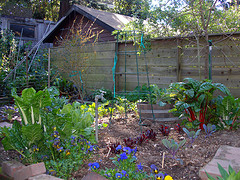- 2 reads

As you go about sealing your home to prevent nature’s temperature and pest intrusions, remember that greening your house is only one part to greening your home. Your backyard has just as much potential to become environmentally friendly as your house does, and with a few easy renovations you can get your garden certified for providing a healthy and sustainable wildlife habitat.
The National Wildlife Federation has provided five areas of improvement that can transform your yard into a five-star hotel of the forest. First, animals need to eat: trees, shrubs, and flowers provide the seeds, berries, and pollen that animals thrive on. Be sure to only plant native plants in your yard, as they grow better in their natural habitat and invasive species can unbalance a delicate ecosystem. During times when food is not as gatherable you can offer birdfeeders, squirrel feeders, and butterfly feeders to provide food for resident and migrant species. A hummingbird feeder and nectar can easily be constructed out of recyclable and household products.
With climate change affecting our sources of clean water, providing a fresh source of water for animals is vital for drinking, bathing, and reproduction. If your backyard does not contain any streams, creeks, ponds, etc., you can purchase a birdbath. Be sure to change the water 2-3 times per week to eliminate possible mosquito eggs, and if you live in a climate with cold winters consider buying a small heater to keep the water from freezing.
Providing shelter for wildlife is important for giving animals cover from the weather, humans, and predators. Different birdfeeders, including ones made out of natural gourds, can help attract specific types of birds you want around your home, and natural shrubbery like bushes, thickets, and even dead trees can offer ideal habitats. Ponds are good cover for fish and amphibians. Most habitat covers are also perfect for raising offspring, from wildflower patches to burrows.
Lastly, how you maintain the land will have the largest effect on the environment. Water for irrigation as well as ponds or birdbaths can be sustainably collected from rainwater, and can be distributed throughout your garden with a drip or soaker hose. Try to reduce the amount of lawn grass in your yard, as it usually requires chemicals and a lot of maintenance with gas-powered mowers. Replacing it with edible plants is much better for your backyard wildlife. Eliminating chemical pesticides and fertilizers can drastically improve the health of your garden. Using compost or mulch helps keep the soil moist by preventing evaporation, and adds nutrients that reduce the need for additional fertilizers. Also, applying mulch in the autumn instead of the spring can add the same nutrients to the soil without as much risk of being washed off with April showers.
Although it may seem redundant, remember that as you go about green-ovating your home the easiest place to make more environmentally-friendly is the environment itself. Don’t take your garden for granted, and if you can’t beat the bunnies that keep biting your begonias you had might as well forget it and feed some friends.

